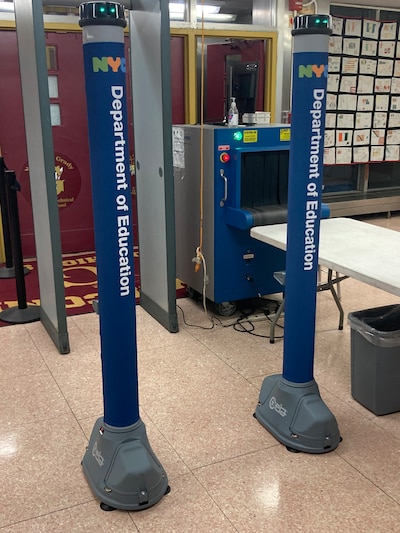As Mayor Eric Adams launches a high-profile effort to pilot new weapons detection technology in the subways, New York City has also begun quietly rolling out new weapons scanners in schools, according to education and police officials.
The NYPD, which oversees school weapons detectors, is in the process of replacing the existing metal detectors at nearly 80 city campuses with new scanners from the company CEIA at a cost of roughly $3.9 million, an NYPD spokesperson confirmed. An additional nine schools will get the new devices for “random scanning” on select days, the spokesperson said.
The new CEIA Opengate scanners for schools, which consist of two wireless, standalone pillars that can be customized with the school’s name and colors, are supposed to feel more welcoming and “less intrusive” to students than the traditional, box-shaped metal detectors, according to Mark Rampersant, the Education Department’s Chief of Safety and Prevention Partnerships.

But Education Department officials aren’t planning to take advantage of the device’s major selling point: allowing students to walk through without removing their backpacks, which would save a significant amount of time.
Instead, New York City schools will continue asking students to put their bags through a separate X-ray machine – the part of the process that usually takes longest – Rampersant said.
“In terms of the students not removing their backpacks, this technology does not allow for that,” Rampersant said Thursday at a press conference. “We’ll continue to use the X-ray machine that tells you what’s in the bag.”
That runs counter to the company’s marketing of the product, which promises that “individuals can go ahead and keep their bags on them,” because the machines can, in theory, distinguish between weapons and other metal devices like cell phones, bottles, and tablets, the company’s website reads.
Nikita Ermolaev, a research engineer who studies CEIA products for IPVM, a security industry research publication, said it’s “extremely rare” for a school district to purchase the CEIA Opengate scanners while continuing to use X-ray bag machines at the same time.
“That raises a lot of questions,” he said. “If one can have a similar experience with traditional metal detectors, why would you need to buy a more expensive unit?”
An Education Department spokesperson referred questions about the new scanners to an NYPD spokesperson, who said “the CEIA Opengate is a low profile detector, however, it does not replace an X-Ray machine.”
More welcoming and portable devices
City officials pointed to two main advantages of the new CEIA scanners. First, since they’re wireless and relatively lightweight, they’re easy to move. That would allow schools to scan students before entering sports games outside, Rampersant said recently to parent leaders.
Officials also say the CEIA devices will feel more welcoming because they can be customized with a school’s logo and colors.
“It has the school’s branding on it so when kids see it … it doesn’t look like a metal detector scanner,” Rampersant said earlier this month at a meeting of the Chancellor’s Parent Advisory Committee.
But Ava Harris, a 16-year-old senior at the Walton Campus in the Bronx, said walking through metal detectors each day makes her feel “like a criminal,” and the design of the scanners won’t change that.
“I find that quite ridiculous,” said Harris, a member of the student groups Urban Youth Collaborative and Sistas & Brothas United, which advocate for the removal of scanners from schools. “I don’t really think the logo of the school or anything would make a difference. It’s still a scanner, kids will still know it’s a scanner.”
Officials didn’t immediately say what will happen with the old scanners or whether they will be repurposed.
CEIA is a competitor of Evolv, the company whose technology Adams touted at his Thursday press conference on subway safety. Evolv has attracted significant scrutiny from experts and government officials over accusations that it overpromises with its aggressive marketing and triggers false alerts on objects like Chromebooks. Ermolaev said CEIA is a more established company and is more conservative in its marketing.
But he said the devices can still miss items, or falsely alert on non-weapons when sensitivity settings are too high.
Ermolaev questioned whether the ability to move and decorate the new devices was worth the additional cost. He pointed out that most traditional metal detectors can be put on wheels and moved, and many can also be customized with school designs.
The major advantage of a system like Opengate is that it can significantly speed up the scanning process by eliminating the need for the X-ray bag machine, he said.
Harris, the Bronx student, suggested the city divert the roughly $4 million it plans to spend on the new scanners to “things that would actually help students like counselors, restorative justice, and conflict mediators.”
Officials offer conflicting messages
Adams and schools Chancellor David Banks have talked for years about introducing new scanners in schools, but officials have recently offered conflicting messages about what those devices will do and the timeline for rolling them out.
At the Chancellor’s Parent Advisory Committee meeting earlier this month Banks said, “we’re trying to get in place … these non-invasive scanners where you don’t have to take everything out.”
He added that he was hopeful that technology is coming “sooner rather than later.”
It’s unclear if Banks was referring to the CEIA Opengate, or a different device.
But Rampersant, later in that same meeting, sounded a more cautious note.
“I don’t think there’s any such thing as less invasive tech, they’re all invasive,” he said. “The scanning machine the Chancellor speaks of, there is no real timeline for that being introduced into … our school system.”
Education Department officials didn’t immediately say how many schools have gotten CEIA scanners, but multiple principals at schools with metal detectors told Chalkbeat they haven’t yet received the new devices.
The city school system has seen a significant uptick in students arriving with weapons and other dangerous items in the wake of the pandemic — a reality students say is driven by safety concerns on the commute to and from school.
So far this school year, the NYPD has collected a total eight guns, 1,774 knives, 455 box cutters and razors, and 1,382 “other” items including pepper spray from students across the city’s roughly 1,600 public schools. That’s down slightly from last year’s totals during the same period, but still up significantly over pre-pandemic numbers.
Rampersant said “more and more of our schools, including our affluent schools, are asking for scanners in the school building.”
But critics have long alleged that the NYPD offers little explanation or rationale for where the scanners are placed.
At one school campus serving middle and elementary school students that got “pop-up” scanning this week, a parent said there was little explanation about why the metal detectors were necessary that morning, and that the scanners caused fear and confusion rather than reassurance.
“It was quite chaotic,” said the East Village elementary school parent, who spoke on the condition of anonymity. “I think really it more alarmed a lot of parents … than assuaged their fears.”
Michael Elsen-Rooney is a reporter for Chalkbeat New York, covering NYC public schools. Contact Michael at melsen-rooney@chalkbeat.org.







